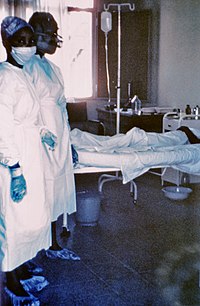
Photo from wikipedia
Background: “Lockdowns” to control serious respiratory virus pandemics were widely used during the coronavirus disease 2019 (COVID-19) pandemic. However, there is limited information to understand the settings in which most… Click to show full abstract
Background: “Lockdowns” to control serious respiratory virus pandemics were widely used during the coronavirus disease 2019 (COVID-19) pandemic. However, there is limited information to understand the settings in which most transmission occurs during lockdowns, to support refinement of similar policies for future pandemics. Methods: Among Virus Watch household cohort participants we identified those infected with severe acute respiratory syndrome coronavirus 2 (SARS-CoV-2) outside the household. Using survey activity data, we undertook multivariable logistic regressions assessing the contribution of activities on non-household infection risk. We calculated adjusted population attributable fractions (APAF) to estimate which activity accounted for the greatest proportion of non-household infections during the pandemic’s second wave. Results: Among 10,858 adults, 18% of cases were likely due to household transmission. Among 10,475 participants (household-acquired cases excluded), including 874 non-household-acquired infections, infection was associated with: leaving home for work or education (AOR 1.20 (1.02 – 1.42), APAF 6.9%); public transport (more than once per week AOR 1.82 (1.49 – 2.23), public transport APAF 12.42%); and shopping (more than once per week AOR 1.69 (1.29 – 2.21), shopping APAF 34.56%). Other non-household activities were rare and not significantly associated with infection. Conclusions: During lockdown, going to work and using public or shared transport independently increased infection risk, however only a minority did these activities. Most participants visited shops, accounting for one-third of non-household transmission. Transmission in restricted hospitality and leisure settings was minimal suggesting these restrictions were effective. If future respiratory infection pandemics emerge these findings highlight the value of working from home, using forms of transport that minimise exposure to others, minimising exposure to shops and restricting non-essential activities.
Journal Title: Wellcome Open Research
Year Published: 2022
Link to full text (if available)
Share on Social Media: Sign Up to like & get
recommendations!